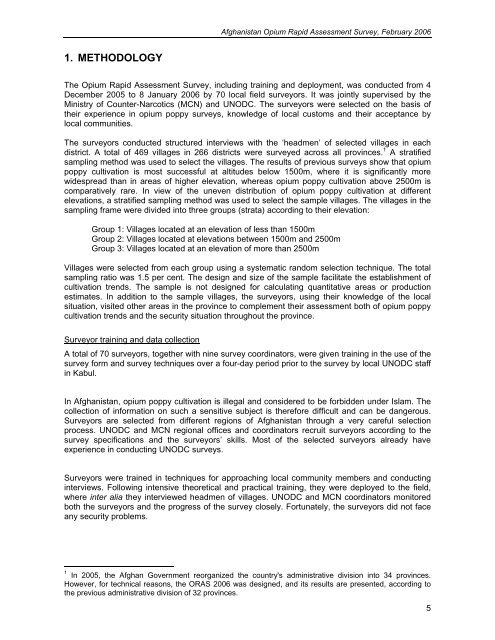AFGHANISTAN - United Nations Office on Drugs and Crime
AFGHANISTAN - United Nations Office on Drugs and Crime
AFGHANISTAN - United Nations Office on Drugs and Crime
You also want an ePaper? Increase the reach of your titles
YUMPU automatically turns print PDFs into web optimized ePapers that Google loves.
Afghanistan Opium Rapid Assessment Survey, February 2006<br />
1. METHODOLOGY<br />
The Opium Rapid Assessment Survey, including training <strong>and</strong> deployment, was c<strong>on</strong>ducted from 4<br />
December 2005 to 8 January 2006 by 70 local field surveyors. It was jointly supervised by the<br />
Ministry of Counter-Narcotics (MCN) <strong>and</strong> UNODC. The surveyors were selected <strong>on</strong> the basis of<br />
their experience in opium poppy surveys, knowledge of local customs <strong>and</strong> their acceptance by<br />
local communities.<br />
The surveyors c<strong>on</strong>ducted structured interviews with the ‘headmen’ of selected villages in each<br />
district. A total of 469 villages in 266 districts were surveyed across all provinces. 1 A stratified<br />
sampling method was used to select the villages. The results of previous surveys show that opium<br />
poppy cultivati<strong>on</strong> is most successful at altitudes below 1500m, where it is significantly more<br />
widespread than in areas of higher elevati<strong>on</strong>, whereas opium poppy cultivati<strong>on</strong> above 2500m is<br />
comparatively rare. In view of the uneven distributi<strong>on</strong> of opium poppy cultivati<strong>on</strong> at different<br />
elevati<strong>on</strong>s, a stratified sampling method was used to select the sample villages. The villages in the<br />
sampling frame were divided into three groups (strata) according to their elevati<strong>on</strong>:<br />
Group 1: Villages located at an elevati<strong>on</strong> of less than 1500m<br />
Group 2: Villages located at elevati<strong>on</strong>s between 1500m <strong>and</strong> 2500m<br />
Group 3: Villages located at an elevati<strong>on</strong> of more than 2500m<br />
Villages were selected from each group using a systematic r<strong>and</strong>om selecti<strong>on</strong> technique. The total<br />
sampling ratio was 1.5 per cent. The design <strong>and</strong> size of the sample facilitate the establishment of<br />
cultivati<strong>on</strong> trends. The sample is not designed for calculating quantitative areas or producti<strong>on</strong><br />
estimates. In additi<strong>on</strong> to the sample villages, the surveyors, using their knowledge of the local<br />
situati<strong>on</strong>, visited other areas in the province to complement their assessment both of opium poppy<br />
cultivati<strong>on</strong> trends <strong>and</strong> the security situati<strong>on</strong> throughout the province.<br />
Surveyor training <strong>and</strong> data collecti<strong>on</strong><br />
A total of 70 surveyors, together with nine survey coordinators, were given training in the use of the<br />
survey form <strong>and</strong> survey techniques over a four-day period prior to the survey by local UNODC staff<br />
in Kabul.<br />
In Afghanistan, opium poppy cultivati<strong>on</strong> is illegal <strong>and</strong> c<strong>on</strong>sidered to be forbidden under Islam. The<br />
collecti<strong>on</strong> of informati<strong>on</strong> <strong>on</strong> such a sensitive subject is therefore difficult <strong>and</strong> can be dangerous.<br />
Surveyors are selected from different regi<strong>on</strong>s of Afghanistan through a very careful selecti<strong>on</strong><br />
process. UNODC <strong>and</strong> MCN regi<strong>on</strong>al offices <strong>and</strong> coordinators recruit surveyors according to the<br />
survey specificati<strong>on</strong>s <strong>and</strong> the surveyors’ skills. Most of the selected surveyors already have<br />
experience in c<strong>on</strong>ducting UNODC surveys.<br />
Surveyors were trained in techniques for approaching local community members <strong>and</strong> c<strong>on</strong>ducting<br />
interviews. Following intensive theoretical <strong>and</strong> practical training, they were deployed to the field,<br />
where inter alia they interviewed headmen of villages. UNODC <strong>and</strong> MCN coordinators m<strong>on</strong>itored<br />
both the surveyors <strong>and</strong> the progress of the survey closely. Fortunately, the surveyors did not face<br />
any security problems.<br />
1 In 2005, the Afghan Government reorganized the country's administrative divisi<strong>on</strong> into 34 provinces.<br />
However, for technical reas<strong>on</strong>s, the ORAS 2006 was designed, <strong>and</strong> its results are presented, according to<br />
the previous administrative divisi<strong>on</strong> of 32 provinces.<br />
5

















